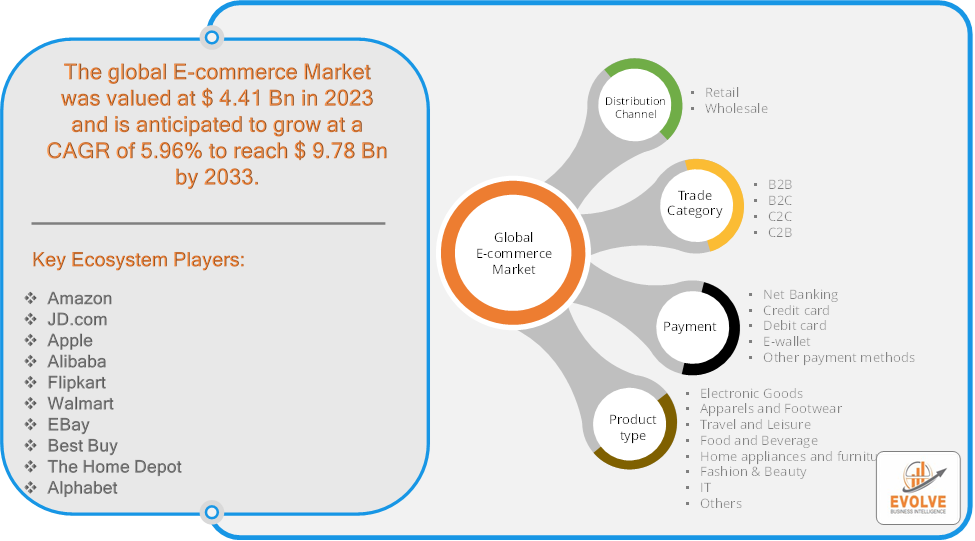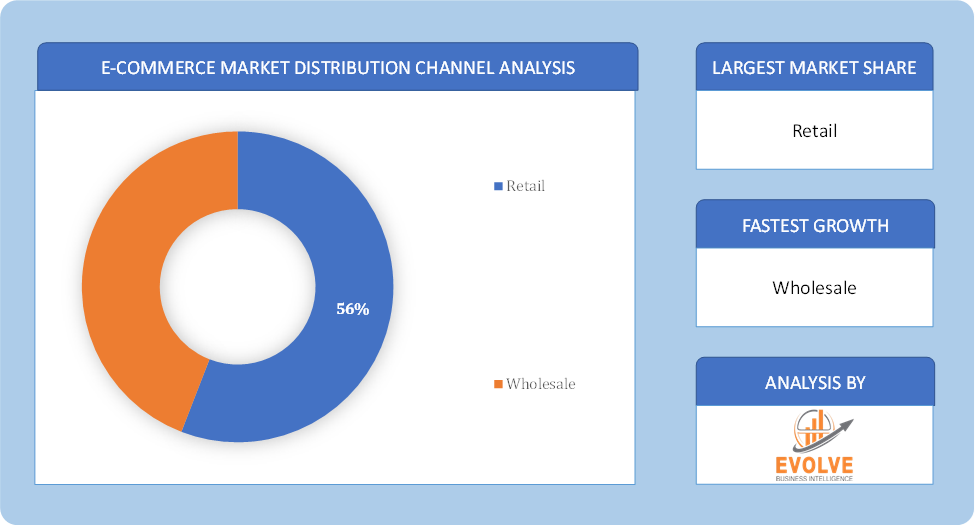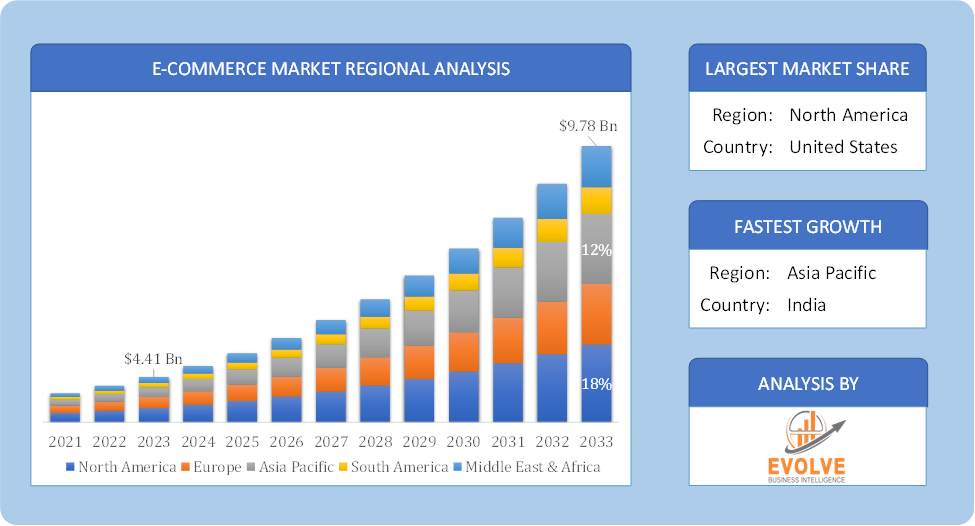E-commerce Market Analysis and Global Forecast 2023-2033
$ 1,390.00 – $ 5,520.00Price range: $ 1,390.00 through $ 5,520.00
E-commerce Market Research Report: By Distribution Channel (Retail, Wholesale), By Trade Category (B2B, B2C, C2C, C2B), By Payment (Net Banking, Credit Card, Debit Card, e-Wallet, Other Payment Methods), By Product type (Electronic Goods, Apparels and Footwear, Travel and Leisure, Food and Beverage, Home Appliances and Furniture, Fashion & Beauty, IT, Others), and by Region — Forecast till 2033
Page: 161
E-commerce Market Overview
E-commerce Market Size is expected to reach USD 9.78 Billion by 2033. The E-commerce industry size accounted for USD 5.96 Billion in 2023 and is expected to expand at a compound annual growth rate (CAGR) of 5.96% from 2023 to 2033. The e-commerce market refers to the buying and selling of goods or services conducted over electronic systems such as the internet and other computer networks. It encompasses a wide range of transactions, from consumer retail purchases to business-to-business trading. E-commerce enables businesses and consumers to connect globally, facilitating transactions without physical boundaries. Key features include online storefronts, digital payment systems, and logistics networks for order fulfillment. The market is characterized by rapid growth driven by technological advancements, changing consumer behavior favoring convenience, and increasing internet penetration worldwide. E-commerce platforms often include marketplace models, where multiple sellers offer products on a single platform, enhancing choice and competition.
Global E-commerce Market Synopsis
 COVID-19 Impact Analysis
COVID-19 Impact Analysis
The COVID-19 pandemic has led to supply chain disruptions leading to supply shortages or lower demand in the E-commerce market. The travel restrictions and social-distancing measures have resulted in a sharp drop in consumer and business spending and this pattern is to continue for some time. The end-user trend and preferences have changed due to the pandemic and have resulted in manufacturers, developers, and service providers to adopt various strategies to stabilize the company.
Global E-commerce Market Dynamics
The major factors that have impacted the growth of E-commerce are as follows:
Drivers:
⮚ Technological Advancements
Innovations in technology continuously enhance the e-commerce experience. This includes advancements in mobile devices, secure payment gateways, AI-driven personalization, virtual reality for enhanced shopping experiences, and logistics solutions like drones and autonomous vehicles for efficient delivery.
Restraint:
- Payment Security and Fraud Prevention
Ensuring secure payment processing and fraud prevention measures is critical. Challenges include managing payment disputes, chargebacks, and ensuring compliance with PCI-DSS standards to protect financial transactions and consumer data.
Opportunity:
⮚ Mobile Commerce (m-commerce)
The proliferation of smartphones and mobile devices has fueled the growth of mobile commerce. Optimizing websites and apps for mobile platforms, implementing mobile payment solutions, and leveraging location-based services present opportunities to enhance customer engagement and increase sales.
E-commerce Market Segment Overview
 By Distribution Channel
By Distribution Channel
Based on the Distribution Channel, the market is segmented based on Retail, Wholesale. retail distribution channels dominate, driven by direct sales to consumers through online platforms. This segment reflects the shift towards digital retailing, where companies sell products directly to end-users, leveraging the convenience and accessibility of online shopping channels.
By Trade Category
Based on Trade Category, the market has been divided into B2B, B2C, C2C, C2B. B2C (Business-to-Consumer) dominates as the largest trade category. It encompasses transactions where businesses sell products or services directly to consumers through online platforms, reflecting the widespread adoption of digital retailing and consumer preferences for online shopping convenience.
By Payment
Based on the Payment, the market has been divided into Net Banking, Credit Card, Debit Card, e-Wallet, Other Payment Methods. Based on the Payment, the market has been divided into Net Banking, Credit Card, Debit Card, e-Wallet, Other Payment Methods.
By Product type
Based on Product type, the market has been divided into Electronic Goods, Apparels and Footwear, Travel and Leisure, Food and Beverage, Home Appliances and Furniture, Fashion & Beauty, IT, Others. Based on Product type, the market has been divided into Electronic Goods, Apparels and Footwear, Travel and Leisure, Food and Beverage, Home Appliances and Furniture, Fashion & Beauty, IT, Others.
Global E-commerce Market Regional Analysis
Based on region, the market has been divided into North America, Europe, Asia-Pacific, the Middle East & Africa, and Latin America. The area of North America is anticipated to dominate the market for the usage of E-commerce, followed by those in Asia-Pacific and Europe.
 E-commerce North America Market
E-commerce North America Market
The North American region holds a dominant position in the E-commerce market. The market for e-commerce in North America is expected to be dominated by rising smartphone adoption, the ease of purchasing online, and the rising desire for specialized products. Furthermore, a boost in company research and development spending would spur the expansion of the e-commerce industry in North America.
E-commerce Asia Pacific Market
The Asia-Pacific region is witnessing rapid growth and emerging as a significant market for the E-commerce industry. The fastest compound annual growth rate (CAGR) is anticipated in the Asia-Pacific E-commerce Market between 2023 and 2032. E-commerce is growing as a result of faster internet, mobile optimization, AI-powered personalization, and safe payment gateways. Additionally, the Asia-Pacific region’s fastest-growing e-commerce market was India, while China held the highest market share.
Competitive Landscape
The competitive landscape includes key players (tier 1, tier 2, and local) having a presence across the globe. Companies such as Amazon, JD.com, Apple, Alibaba, and Flipkart are some of the leading players in the global E-commerce Industry. These players have adopted partnership, acquisition, expansion, and new product development, among others as their key strategies.
Key Market Players:
- Amazon
- com
- Apple
- Alibaba
- Flipkart
- Walmart
- EBay
- Best Buy
- The Home Depot
- Alphabet
Key Development:
In September 2022, Flipkart focused on expanding its logistics network and enhancing customer experience through technology integration, aiming to strengthen its position in the competitive e-commerce landscape.
Scope of the Report
Global E-commerce Market, by Distribution Channel
- Retail
- Wholesale
Global E-commerce Market, by Trade Category
- B2B
- B2C
- C2C
- C2B
Global E-commerce Market, by Payment
- Net Banking
- Credit card
- Debit card
- E-wallet
- Other payment methods
Global E-commerce Market, by Product type
- Electronic Goods
- Apparels and Footwear
- Travel and Leisure
- Food and Beverage
- Home appliances and furniture
- Fashion & Beauty
- IT
- Others
Global E-commerce Market, by Region
- North America
- US
- Canada
- Mexico
- Europe
- UK
- Germany
- France
- Italy
- Spain
- Benelux
- Nordic
- Rest of Europe
- Asia Pacific
- China
- Japan
- South Korea
- Indonesia
- Austalia
- Malaysia
- India
- Rest of Asia Pacific
- South America
- Brazil
- Argentina
- Rest of South America
- Middle East & Africa
- Saudi Arabia
- UAE
- Egypt
- South Africa
- Rest of Middle East & Africa
| Parameters | Indicators |
|---|---|
| Market Size | 2033: USD 9.78 Billion |
| CAGR (2023-2033) | 5.96% |
| Base year | 2022 |
| Forecast Period | 2023-2033 |
| Historical Data | 2021 (2017 to 2020 On Demand) |
| Report Coverage | Revenue Forecast, Competitive Landscape, Growth Factors, and Trends |
| Key Segmentations | Distribution Channel, Trade Category, Payment, Product type |
| Geographies Covered | North America, Europe, Asia-Pacific, South America, Middle East, Africa |
| Key Vendors | Amazon, JD.com, Apple, Alibaba, Flipkart, Walmart, EBay, Best Buy, The Home Depot, Alphabet. |
| Key Market Opportunities | E-commerce penetration in developing countries offers vast growth potential |
| Key Market Drivers | Expanding internet access and cross-border trade regulations pave the way for e-commerce opportunities. |
REPORT CONTENT BRIEF:
- High-level analysis of the current and future E-commerce Industry trends and opportunities
- Detailed analysis of current market drivers, restraining factors, and opportunities analysis in the future
- Historical market size for the year 2021, and forecast from 2023 to 2033
- E-commerce market share analysis for each segment
- Competitor analysis with a comprehensive insight into its product segment, financial strength, and strategies adopted.
- Identifies key strategies adopted by the key players including new product development, mergers and acquisitions, joint ventures, collaborations, and partnerships.
- To identify and understand the various factors involved in the global E-commerce market affected by the pandemic
- To provide year-on-year growth from 2022 to 2033
- To provide short-term, long-term, and overall CAGR comparison from 2022 to 2033.
- Provide Total Addressable Market (TAM) for the Global E-commerce Market.
Frequently Asked Questions (FAQ)
What is the study period of this market?
The study period of the global E-commerce market is 2022- 2033
What are the 10 Years CAGR (2023 to 2033) of the global E-commerce market?
The global E-commerce market is growing at a CAGR of ~5.96% over the next 10 years
Which region has the highest growth rate in the market of E-commerce?
Asia Pacific is expected to register the highest CAGR during 2023-2033
Which region accounted for the largest share of the market of E-commerce?
North America holds the largest share in 2022
Major Key Players in the Market of E-commerce?
Amazon, JD.com, Apple, Alibaba, Flipkart, Walmart, EBay, Best Buy, The Home Depot, and Alphabet are the major companies operating in the E-commerce Industry.
Do you offer Post Sale Support?
Yes, we offer 16 hours of analyst support to solve the queries
Do you deliver sections of a report?
Yes, we do provide regional as well as country-level reports. Other than this we also provide a sectional report. Please get in contact with our sales representatives.
Press Release

Global Pharmaceutical Manufacturing Market to Reach $1.38 Trillion by 2035 with 7.35% CAGR, New Research Shows

The Global Mammography Market Is Estimated To Record a CAGR of Around 10.29% During The Forecast Period

Glue Stick Market to Reach USD 2.35 Billion by 2034

Podiatry Service Market to Reach USD 11.88 Billion by 2034

Microfluidics Technology Market to Reach USD 32.58 Billion by 2034

Ferric Chloride Market to Reach USD 10.65 Billion by 2034

Family Practice EMR Software Market to Reach USD 21.52 Billion by 2034

Electric Hairbrush Market to Reach USD 15.95 Billion by 2034

Daily Bamboo Products Market to Reach USD 143.52 Billion by 2034

Cross-border E-commerce Logistics Market to Reach USD 112.65 Billion by 2034
Table of Content
CHAPTER 1. Executive Summary CHAPTER 2. Scope of the Study 2.1. Market Definition 2.2. Market Scope & Segmentation 2.2.1. Objective of Report CHAPTER 3. Evolve BI Methodology 3.1. Data Collection & Validation Approach 3.2. Market Size Estimation and Forecast CHAPTER 4. Exclusive Analysis 4.1. Market Opportunity Score 4.1.1. Distribution Channel Segement – Market Opportunity Score 4.1.2. Trade Category Segment – Market Opportunity Score 4.1.3. Payment Segment – Market Opportunity Score 4.1.4. Product type Segment – Market Opportunity Score 4.2. Key Market Influencing Indicators CHAPTER 5. Market Insights and Trends 5.1. Value Chain Analysis 5.1.1. Distribution Channel 5.1.2. Manufacturing Process 5.1.3. Distribution Channel 5.1.4. End User 5.2. Porter’s Five Forces Analysis 5.2.1. Bargaining Power of Buyers 5.2.2. Bargaining Power of Suppliers 5.2.3. Threat of New Entrant 5.2.4. Threat of Substitute 5.2.5. Industry Rivalry 5.3. COVID-19 Impact and Post COVID Scenario on E-commerce Market 5.3.1. Impact of COVID-19 5.3.2. Government Support and Industry Revival Policies 5.3.3. Measures Taken by Companies to Mitigate Negative Impact 5.3.4. Post COVID Trend CHAPTER 6. MArket Dynamics 6.1. Introduction 6.2. Drivers 6.2.1. Driver 1 6.2.2. Driver 2 6.2.3. Driver 3 6.3. Restraints 6.3.1. Restraint 1 6.3.2. Restraint 2 6.4. Opportunity 6.4.1. Opportunity 1 CHAPTER 7. Global E-commerce Market, By Distribution Channel 7.1. Introduction 7.1.1. Retail 7.1.2. Wholesale CHAPTER 8. Global E-commerce Market, By Trade Category 8.1. Introduction 8.1.1. B2B 8.1.2. B2C 8.1.3. C2C 8.1.4. C2B CHAPTER 9. Global E-commerce Market, By Payment 9.1. Introduction 9.1.1. Net Banking 9.1.2. Credit card 9.1.3. Debit card 9.1.4. E-wallet 9.1.5. Other payment methods CHAPTER 10. Global E-commerce Market, By Product type 10.1. Introduction 10.1.1. Electronic Goods 10.1.2. Apparels and Footwear 10.1.3. Travel and Leisure 10.1.4. Food and Beverage 10.1.5. Home appliances and furniture 10.1.6. Fashion & Beauty 10.1.7. IT 10.1.8. Others CHAPTER 11. Global E-commerce Market, By Region 11.1. Introduction 11.2. NORTH AMERICA 11.2.1. North America: Market Size and Forecast, By Country, 2023 – 2033 ($ Million) 11.2.2. North America: Market Size and Forecast, By Distribution Channel, 2023 – 2033 ($ Million) 11.2.3. North America: Market Size and Forecast, By Trade Category, 2023 – 2033 ($ Million) 11.2.4. North America: Market Size and Forecast, By Payment, 2023 – 2033 ($ Million) 11.2.5. North America: Market Size and Forecast, By Product type, 2023 – 2033 ($ Million) 11.2.6. US 11.2.6.1. US: Market Size and Forecast, By Distribution Channel, 2023 – 2033 ($ Million) 11.2.6.2. US: Market Size and Forecast, By Trade Category, 2023 – 2033 ($ Million) 11.2.6.3. US: Market Size and Forecast, By Payment, 2023 – 2033 ($ Million) 11.2.6.4. US: Market Size and Forecast, By Product type, 2023 – 2033 ($ Million) 11.2.7. CANADA 11.2.7.1. Canada: Market Size and Forecast, By Distribution Channel, 2023 – 2033 ($ Million) 11.2.7.2. Canada: Market Size and Forecast, By Trade Category, 2023 – 2033 ($ Million) 11.2.7.3. Canada: Market Size and Forecast, By Payment, 2023 – 2033 ($ Million) 11.2.7.4. Canada: Market Size and Forecast, By Product type, 2023 – 2033 ($ Million) 11.2.8. MEXICO 11.2.8.1. Mexico: Market Size and Forecast, By Distribution Channel, 2023 – 2033 ($ Million) 11.2.8.2. Mexico: Market Size and Forecast, By Trade Category, 2023 – 2033 ($ Million) 11.2.8.3. Mexico: Market Size and Forecast, By Payment, 2023 – 2033 ($ Million) 11.2.8.4. Mexico: Market Size and Forecast, By Product type, 2023 – 2033 ($ Million) 11.3. Europe 11.3.1. Europe: Market Size and Forecast, By Country, 2023 – 2033 ($ Million) 11.3.2. Europe: Market Size and Forecast, By Distribution Channel, 2023 – 2033 ($ Million) 11.3.3. Europe: Market Size and Forecast, By Trade Category, 2023 – 2033 ($ Million) 11.3.4. Europe: Market Size and Forecast, By Payment, 2023 – 2033 ($ Million) 11.3.5. Europe: Market Size and Forecast, By Product type, 2023 – 2033 ($ Million) 11.3.6. U.K. 11.3.6.1. U.K.: Market Size and Forecast, By Distribution Channel, 2023 – 2033 ($ Million) 11.3.6.2. U.K.: Market Size and Forecast, By Trade Category, 2023 – 2033 ($ Million) 11.3.6.3. U.K.: Market Size and Forecast, By Payment, 2023 – 2033 ($ Million) 11.3.6.4. U.K.: Market Size and Forecast, By Product type, 2023 – 2033 ($ Million) 11.3.7. GERMANY 11.3.7.1. Germany: Market Size and Forecast, By Distribution Channel, 2023 – 2033 ($ Million) 11.3.7.2. Germany: Market Size and Forecast, By Trade Category, 2023 – 2033 ($ Million) 11.3.7.3. Germany: Market Size and Forecast, By Payment, 2023 – 2033 ($ Million) 11.3.7.4. Germany: Market Size and Forecast, By Product type, 2023 – 2033 ($ Million) 11.3.8. FRANCE 11.3.8.1. France: Market Size and Forecast, By Distribution Channel, 2023 – 2033 ($ Million) 11.3.8.2. France: Market Size and Forecast, By Trade Category, 2023 – 2033 ($ Million) 11.3.8.3. France: Market Size and Forecast, By Payment, 2023 – 2033 ($ Million) 11.3.8.4. France: Market Size and Forecast, By Product type, 2023 – 2033 ($ Million) 11.3.9. ITALY 11.3.9.1. Italy: Market Size and Forecast, By Distribution Channel, 2023 – 2033 ($ Million) 11.3.9.2. Italy: Market Size and Forecast, By Trade Category, 2023 – 2033 ($ Million) 11.3.9.3. Italy: Market Size and Forecast, By Payment, 2023 – 2033 ($ Million) 11.3.9.4. Italy: Market Size and Forecast, By Product type, 2023 – 2033 ($ Million) 11.3.10. SPAIN 11.3.10.1. Spain: Market Size and Forecast, By Distribution Channel, 2023 – 2033 ($ Million) 11.3.10.2. Spain: Market Size and Forecast, By Trade Category, 2023 – 2033 ($ Million) 11.3.10.3. Spain: Market Size and Forecast, By Payment, 2023 – 2033 ($ Million) 11.3.10.4. Spain: Market Size and Forecast, By Product type, 2023 – 2033 ($ Million) 11.3.11. BENELUX 11.3.11.1. BeNeLux: Market Size and Forecast, By Distribution Channel, 2023 – 2033 ($ Million) 11.3.11.2. BeNeLux: Market Size and Forecast, By Trade Category, 2023 – 2033 ($ Million) 11.3.11.3. BeNeLux: Market Size and Forecast, By Payment, 2023 – 2033 ($ Million) 11.3.11.4. BeNeLux: Market Size and Forecast, By Product type, 2023 – 2033 ($ Million) 11.3.12. RUSSIA 11.3.12.1. Russia: Market Size and Forecast, By Distribution Channel, 2023 – 2033 ($ Million) 11.3.12.2. Russia: Market Size and Forecast, By Trade Category, 2023 – 2033 ($ Million) 11.3.12.3. Russia: Market Size and Forecast, By Payment, 2023 – 2033 ($ Million) 11.3.12.4. Russia: Market Size and Forecast, By Product type, 2023 – 2033 ($ Million) 11.3.13. REST OF EUROPE 11.3.13.1. Rest of Europe: Market Size and Forecast, By Distribution Channel, 2023 – 2033 ($ Million) 11.3.13.2. Rest of Europe: Market Size and Forecast, By Trade Category, 2023 – 2033 ($ Million) 11.3.13.3. Rest of Europe: Market Size and Forecast, By Payment, 2023 – 2033 ($ Million) 11.3.13.4. Rest of Europe: Market Size and Forecast, By Product type, 2023 – 2033 ($ Million) 11.4. Asia Pacific 11.4.1. Asia Pacific: Market Size and Forecast, By Country, 2023 – 2033 ($ Million) 11.4.2. Asia Pacific: Market Size and Forecast, By Distribution Channel, 2023 – 2033 ($ Million) 11.4.3. Asia Pacific: Market Size and Forecast, By Trade Category, 2023 – 2033 ($ Million) 11.4.4. Asia Pacific: Market Size and Forecast, By Payment, 2023 – 2033 ($ Million) 11.4.5. Asia Pacific: Market Size and Forecast, By Product type, 2023 – 2033 ($ Million) 11.4.6. CHINA 11.4.6.1. China: Market Size and Forecast, By Distribution Channel, 2023 – 2033 ($ Million) 11.4.6.2. China: Market Size and Forecast, By Trade Category, 2023 – 2033 ($ Million) 11.4.6.3. China: Market Size and Forecast, By Payment, 2023 – 2033 ($ Million) 11.4.6.4. China: Market Size and Forecast, By Product type, 2023 – 2033 ($ Million) 11.4.7. JAPAN 11.4.7.1. Japan: Market Size and Forecast, By Distribution Channel, 2023 – 2033 ($ Million) 11.4.7.2. Japan: Market Size and Forecast, By Trade Category, 2023 – 2033 ($ Million) 11.4.7.3. Japan: Market Size and Forecast, By Payment, 2023 – 2033 ($ Million) 11.4.7.4. Japan: Market Size and Forecast, By Product type, 2023 – 2033 ($ Million) 11.4.8. INDIA 11.4.8.1. India: Market Size and Forecast, By Distribution Channel, 2023 – 2033 ($ Million) 11.4.8.2. India: Market Size and Forecast, By Trade Category, 2023 – 2033 ($ Million) 11.4.8.3. India: Market Size and Forecast, By Payment, 2023 – 2033 ($ Million) 11.4.8.4. India: Market Size and Forecast, By Product type, 2023 – 2033 ($ Million) 11.4.9. SOUTH KOREA 11.4.9.1. South Korea: Market Size and Forecast, By Distribution Channel, 2023 – 2033 ($ Million) 11.4.9.2. South Korea: Market Size and Forecast, By Trade Category, 2023 – 2033 ($ Million) 11.4.9.3. South Korea: Market Size and Forecast, By Payment, 2023 – 2033 ($ Million) 11.4.9.4. South Korea: Market Size and Forecast, By Product type, 2023 – 2033 ($ Million) 11.4.10. THAILAND 11.4.10.1. Thailand: Market Size and Forecast, By Distribution Channel, 2023 – 2033 ($ Million) 11.4.10.2. Thailand: Market Size and Forecast, By Trade Category, 2023 – 2033 ($ Million) 11.4.10.3. Thailand: Market Size and Forecast, By Payment, 2023 – 2033 ($ Million) 11.4.10.4. Thailand: Market Size and Forecast, By Product type, 2023 – 2033 ($ Million) 11.4.11. INDONESIA 11.4.11.1. Indonesia: Market Size and Forecast, By Distribution Channel, 2023 – 2033 ($ Million) 11.4.11.2. Indonesia: Market Size and Forecast, By Trade Category, 2023 – 2033 ($ Million) 11.4.11.3. Indonesia: Market Size and Forecast, By Payment, 2023 – 2033 ($ Million) 11.4.11.4. Indonesia: Market Size and Forecast, By Product type, 2023 – 2033 ($ Million) 11.4.12. MALAYSIA 11.4.12.1. Malaysia: Market Size and Forecast, By Distribution Channel, 2023 – 2033 ($ Million) 11.4.12.2. Malaysia: Market Size and Forecast, By Trade Category, 2023 – 2033 ($ Million) 11.4.12.3. Malaysia: Market Size and Forecast, By Payment, 2023 – 2033 ($ Million) 11.4.12.4. Malaysia: Market Size and Forecast, By Product type, 2023 – 2033 ($ Million) 11.4.13. AUSTRALIA 11.4.13.1. Australia: Market Size and Forecast, By Distribution Channel, 2023 – 2033 ($ Million) 11.4.13.2. Australia: Market Size and Forecast, By Trade Category, 2023 – 2033 ($ Million) 11.4.13.3. Australia: Market Size and Forecast, By Payment, 2023 – 2033 ($ Million) 11.4.13.4. Australia: Market Size and Forecast, By Product type, 2023 – 2033 ($ Million) 11.4.14. REST FO ASIA PACIFIC 11.4.14.1. Rest fo Asia Pacific: Market Size and Forecast, By Distribution Channel, 2023 – 2033 ($ Million) 11.4.14.2. Rest fo Asia Pacific: Market Size and Forecast, By Trade Category, 2023 – 2033 ($ Million) 11.4.14.3. Rest fo Asia Pacific: Market Size and Forecast, By Payment, 2023 – 2033 ($ Million) 11.4.14.4. Rest fo Asia Pacific: Market Size and Forecast, By Product type, 2023 – 2033 ($ Million) 11.5. South America 11.5.1. South America: Market Size and Forecast, By Country, 2023 – 2033 ($ Million) 11.5.2. South America: Market Size and Forecast, By Distribution Channel, 2023 – 2033 ($ Million) 11.5.3. South America: Market Size and Forecast, By Trade Category, 2023 – 2033 ($ Million) 11.5.4. South America: Market Size and Forecast, By Payment, 2023 – 2033 ($ Million) 11.5.5. South America: Market Size and Forecast, By Product type, 2023 – 2033 ($ Million) 11.5.6. BRAZIL 11.5.6.1. Brazil: Market Size and Forecast, By Distribution Channel, 2023 – 2033 ($ Million) 11.5.6.2. Brazil: Market Size and Forecast, By Trade Category, 2023 – 2033 ($ Million) 11.5.6.3. Brazil: Market Size and Forecast, By Payment, 2023 – 2033 ($ Million) 11.5.6.4. Brazil: Market Size and Forecast, By Product type, 2023 – 2033 ($ Million) 11.5.7. ARGENTINA 11.5.7.1. Argentina: Market Size and Forecast, By Distribution Channel, 2023 – 2033 ($ Million) 11.5.7.2. Argentina: Market Size and Forecast, By Trade Category, 2023 – 2033 ($ Million) 11.5.7.3. Argentina: Market Size and Forecast, By Payment, 2023 – 2033 ($ Million) 11.5.7.4. Argentina: Market Size and Forecast, By Product type, 2023 – 2033 ($ Million) 11.5.8. REST OF SOUTH AMERICA 11.5.8.1. Rest of South America: Market Size and Forecast, By Distribution Channel, 2023 – 2033 ($ Million) 11.5.8.2. Rest of South America: Market Size and Forecast, By Trade Category, 2023 – 2033 ($ Million) 11.5.8.3. Rest of South America: Market Size and Forecast, By Payment, 2023 – 2033 ($ Million) 11.5.8.4. Rest of South America: Market Size and Forecast, By Product type, 2023 – 2033 ($ Million) 11.6. Middle East & Africa 11.6.1. Middle East & Africa: Market Size and Forecast, By Country, 2023 – 2033 ($ Million) 11.6.2. Middle East & Africa: Market Size and Forecast, By Distribution Channel, 2023 – 2033 ($ Million) 11.6.3. Middle East & Africa: Market Size and Forecast, By Trade Category, 2023 – 2033 ($ Million) 11.6.4. Middle East & Africa: Market Size and Forecast, By Payment, 2023 – 2033 ($ Million) 11.6.5. Middle East & Africa: Market Size and Forecast, By Product type, 2023 – 2033 ($ Million) 11.6.6. SAUDI ARABIA 11.6.6.1. Saudi Arabia: Market Size and Forecast, By Distribution Channel, 2023 – 2033 ($ Million) 11.6.6.2. Saudi Arabia: Market Size and Forecast, By Trade Category, 2023 – 2033 ($ Million) 11.6.6.3. Saudi Arabia: Market Size and Forecast, By Payment, 2023 – 2033 ($ Million) 11.6.6.4. Saudi Arabia: Market Size and Forecast, By Product type, 2023 – 2033 ($ Million) 11.6.7. UAE 11.6.7.1. UAE: Market Size and Forecast, By Distribution Channel, 2023 – 2033 ($ Million) 11.6.7.2. UAE: Market Size and Forecast, By Trade Category, 2023 – 2033 ($ Million) 11.6.7.3. UAE: Market Size and Forecast, By Payment, 2023 – 2033 ($ Million) 11.6.7.4. UAE: Market Size and Forecast, By Product type, 2023 – 2033 ($ Million) 11.6.8. EGYPT 11.6.8.1. Egypt: Market Size and Forecast, By Distribution Channel, 2023 – 2033 ($ Million) 11.6.8.2. Egypt: Market Size and Forecast, By Trade Category, 2023 – 2033 ($ Million) 11.6.8.3. Egypt: Market Size and Forecast, By Payment, 2023 – 2033 ($ Million) 11.6.8.4. Egypt: Market Size and Forecast, By Product type, 2023 – 2033 ($ Million) 11.6.9. SOUTH AFRICA 11.6.9.1. South Africa: Market Size and Forecast, By Distribution Channel, 2023 – 2033 ($ Million) 11.6.9.2. South Africa: Market Size and Forecast, By Trade Category, 2023 – 2033 ($ Million) 11.6.9.3. South Africa: Market Size and Forecast, By Payment, 2023 – 2033 ($ Million) 11.6.9.4. South Africa: Market Size and Forecast, By Product type, 2023 – 2033 ($ Million) 11.6.10. REST OF MIDDLE EAST & AFRICA 11.6.10.1. Rest of Middle East & Africa: Market Size and Forecast, By Distribution Channel, 2023 – 2033 ($ Million) 11.6.10.2. Rest of Middle East & Africa: Market Size and Forecast, By Trade Category, 2023 – 2033 ($ Million) 11.6.10.3. Rest of Middle East & Africa: Market Size and Forecast, By Payment, 2023 – 2033 ($ Million) 11.6.10.4. Rest of Middle East & Africa: Market Size and Forecast, By Product type, 2023 – 2033 ($ Million) CHAPTER 12. Competitive Landscape 12.1. Competitior Benchmarking 2023 12.2. Market Share Analysis 12.3. Key Developments Analysis By Top 5 Companies 12.4. Market Share Acquisition Strategies: Analysis of Key Approaches Employed by Top Players CHAPTER 13. Company Profiles 13.1. Amazon 13.1.1. Business Overview 13.1.2. Financial Analysis 13.1.2.1. Business Segment Revenue, 2018, 2019, 2020, $ Million 13.1.2.2. Geographic Revenue Mix, 2020 (% Share) 13.1.3. Product Portfolio 13.1.4. Recent Development and Strategies Adopted 13.1.5. SWOT Analysis 13.2. JD.com 13.3. Apple 13.4. Alibaba 13.5. Flipkart 13.6. Walmart 13.7. EBay 13.8. Best Buy 13.9. The Home Depot 13.10. Alphabet
Connect to Analyst
Research Methodology



 E-commerce North America Market
E-commerce North America Market


